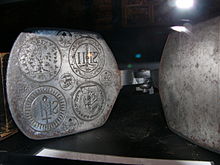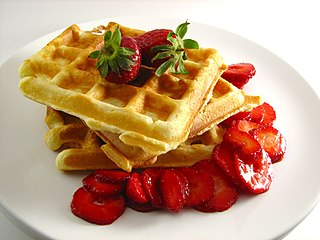
A waffle is a dish made from leavened batter or dough that is cooked between two plates that are patterned to give a characteristic size, shape, and surface impression. There are many variations based on the type of waffle iron and recipe used. Waffles are eaten throughout the world, particularly in Belgium, which has over a dozen regional varieties. Waffles may be made fresh or simply heated after having been commercially cooked and frozen.

A pancake is a flat cake, often thin and round, prepared from a starch-based batter that may contain eggs, milk and butter and cooked on a hot surface such as a griddle or frying pan, often frying with oil or butter. It is a type of batter bread. Archaeological evidence suggests that pancakes were probably eaten in prehistoric societies.
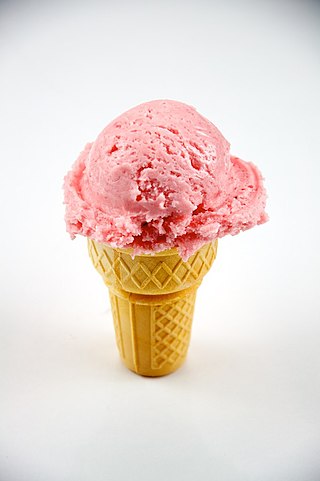
An ice cream cone or poke (Ireland/Scotland) is a brittle, cone-shaped pastry, usually made of a wafer similar in texture to a waffle, made so ice cream can be carried and eaten without a bowl or spoon, for example, the Hong Kong–style bubble cone. Many styles of cones are made, including pretzel cones, sugar-coated and chocolate-coated cones. The term ice cream cone can also refer, informally, to the cone with one or more scoops of ice cream on top.
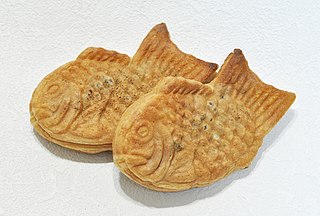
Taiyaki is a Japanese fish-shaped cake, commonly sold as street food. It imitates the shape of tai, which it is named after. The most common filling is red bean paste that is made from sweetened adzuki beans. Other common fillings may be custard, chocolate, cheese, or sweet potato. Some shops even sell taiyaki with okonomiyaki, gyoza filling, or a sausage inside. Smaller, differently shaped versions called kingyoyaki are also available and often sold in bags of five, ten, or more.

Æbleskiver are spherical Danish snacks made from fried batter. The name literally means "apple slices" in Danish, although apples are not usually an ingredient in present-day versions. The crust is similar in texture to European pancakes, but with a light and fluffy interior similar to a Yorkshire pudding. The English language spelling is usually aebleskiver,ebleskiver or ebelskiver.
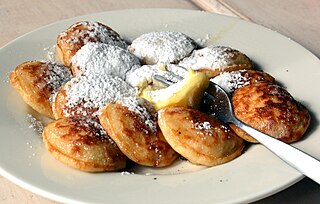
Poffertjes are a traditional Dutch batter treat. Resembling small, fluffy pancakes, they are made with yeast and buckwheat flour. Typically, poffertjes are a sweet treat, served with powdered sugar and butter, and sometimes syrup or advocaat. However, there is also a savoury variant with gouda cheese.

A pie iron—also called pudgy pie iron, sandwich toaster, snackwicher, toastie maker—is a cooking appliance that consists of two hinged concave, round or square, cast iron or aluminium plates on long handles. Its "clamshell" design resembles that of a waffle iron, but without that appliance's honeycomb pattern. Pie irons are used to heat, toast and seal the sandwich.
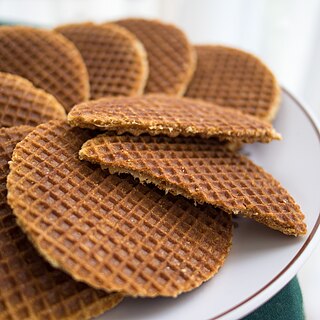
A stroopwafel is a thin, round waffle cookie made from two layers of sweet baked dough held together by syrup filling. First made in the city of Gouda in South Holland, stroopwafels are a well-known Dutch treat popular throughout the Netherlands and abroad.
Hamilton Beach Brands Holding Company is an American designer, marketer and distributor of home appliances and commercial restaurant equipment marketed primarily in the United States, Canada, and Mexico, including blenders, mixers, toasters, slow cookers, clothes irons, and air purifiers.

Krumkake is a Norwegian waffle cookie made of flour, butter, eggs, sugar, and cream.

Kue is an Indonesian bite-sized snack or dessert food. Kue is a fairly broad term in Indonesian to describe a wide variety of snacks including cakes, cookies, fritters, pies, scones, and patisserie. Kue are made from a variety of ingredients in various forms; some are steamed, fried or baked. They are popular snacks in Indonesia, which has the largest variety of kue. Because of the countries' historical colonial ties, Koeé (kue) is also popular in the Netherlands.

An egg waffle is a spherical egg-based waffle popular in Hong Kong and Macau, consisting of an eggy leavened batter cooked between two plates of semi-spherical cells. They are usually served hot, and often eaten plain, although they may be served with fruit and flavors such as strawberry, coconut or chocolate. It is referred to by its original Cantonese name, gai daan jai (雞蛋仔), and in English, an egg puff, bubble waffle, eggette, pancake balls, pancake waffle, egglet, and puffle. They are sometimes referred to as Hong Kong cakes in Chinatowns across America, especially in New York. One piece of egg waffle can have around 20 to 35 small round 'balls'.

Kue semprong, Asian egg roll, sapit, sepit, kue Belanda, or kapit, is an Indonesian traditional wafer snack made by clasping egg batter using an iron mold which is heated up on a charcoal stove. It is commonly found in Indonesia, Malaysia, Singapore and Brunei.

Cornelius Swartwout was an American inventor who filed an early US patent related to waffle irons.
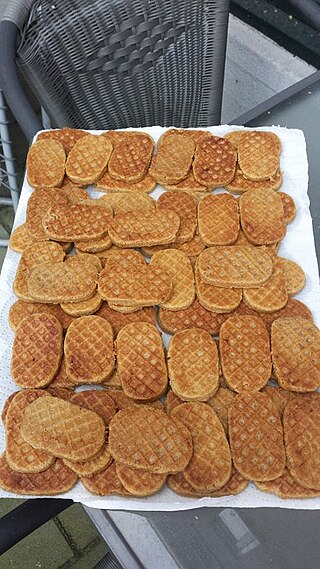
An ijzerkoekje is a soft cookie, traditionally eaten by Dutch fishermen, especially in Vlaardingen, one of the main harbours of the Netherlands during the 19th and 20th centuries. It is an oval cookie around 0.6-0.7 cm thick with a cinnamon 'creamy' taste. The cookies were invented in the city of Vlaardingen and are baked on a checkered iron plate, creating a characteristic waffle-like pattern, similar to stroopwafels.

Kue gapit is an Indonesian kue kering which originates from Cirebon, West Java. Generally made from tapioca flour, its name comes from the cooking process, in which it is grilled between iron molds like a waffle. The snack comes in a variety of shapes and flavors. Though it is a popular souvenir among visitors to Cirebon, residents of the region rarely eat it.

Kue ape or serabi Jakarta is a popular traditional kue pancake with soft and fluffy center surrounded with thin and crispy crepes, commonly found as a popular street food in Indonesia, especially in Jakarta and other major cities. It is also popularly known as kue cucur tipis, which is different from the thicker kue cucur, and colloquially known as kue tetek due to its shape that resembles a nipple. Because it is deemed inappropriate to say ‘tetek’, most Indonesians just say kue ape as in “what cake?”. It is also very similar to serabi Solo.

Dadar gulung is a popular traditional kue of sweet coconut pancake. It is often described as an Indonesian coconut pancake.

Kue rangi or also called sagu rangi is an Indonesian coconut kue or traditional snack made of a coconut and starch-based batter and cooked in a special molded pan. It is one of the traditional Betawi snack of Jakarta. Kue rangi often described as Indonesian coconut waffle.



